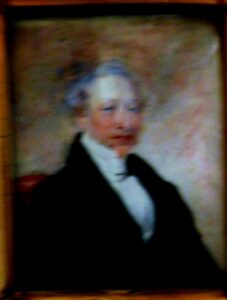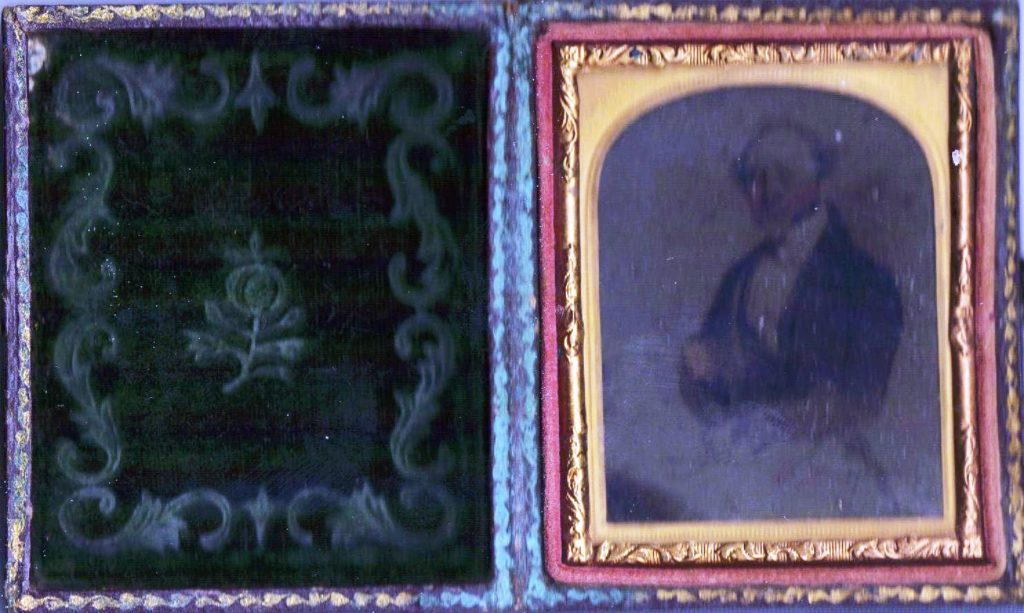Richard Evans was born on 26 Aug 1797 probably in The Red Lion Inn in Wolverhampton. He was baptised at St Peter’s Collegiate Church in Wolverhampton on 27 September 1800. We have a glass rummer monogrammed ‘RE’ that dates from his childhood or even christening.

Richard Evans
Richard would have been brought up in the surrounds of the coaching business. His father, by all accounts was highly involved in all aspects of the business which clearly involved dealing with people of all classes – from traveling dignitaries to stable hands. It appears that Richard (jnr) took over a new venture in the New Hotel in Wolverhampton that was set up in about 1820. The best account of this can be found in Charles George Harper “The Holyhead Road”
In 1824 he married Mary Shaw-Hellier and had a large family. It is clear he became very wealthy in this period as a large number of artefacts still remain in family possession. This wealth may largely have come from the successful coaching business but it would also appear that Mary received a considerable inheritance in the 1830’s. Crested Silver that we have is hallmarked in the 1820’s so the family were acting the part of the gentry even if they were keenly engaged in commerce. In the 1841 census, taken a few months after Richard Evans’ father’s death Richard is listed as a farmer, and again in 1851 farming 950 acres with 44 labourers. He was living at Pendeford Hall a large mansion which was rented from the Fowler family from about 1825-1853.
His bachelor brother Thomas was at this time engaged in the horse breeding and trading business as we have his stud book dated 1833. With the advent of the railway the days of the stage coach were numbered. It is recounted by ‘Nimrod’ how in 1838 the “Wonder” stage coach beat the train in a race from London to Wolverhampton, but the writing was on the wall. The diversification into becoming landed gentry was however also a difficult financial move because of rapidly falling agricultural prices. We have a telling drawing of this period that shows the dramatic decline of “The Wonder” – together with a little poem. It could have been drawn by Sarah Evans, his only daughter.
The challenges were considerable for both Richard and his six surviving sons. The eldest son, Richard, qualified as an attorney and seems to have traveled to Canada and then latterly back to London but although mentioned in his mother’s will in 1874 we know very little else about him. Charles went to first Australia and founded an Evans dynasty later in New Zealand. Thomas who married Sarah Agard, abandoned his family and also ended up in Australia. Some of the Agard Evans family, descendents of Thomas, ended up in Switzerland. Daguerreotypes exist of all these children.
This website has more information on the youngest son Henry Evans who became a Bank Manager and who with his sister Sarah inherited most of the family heirlooms at their mother’s death in 1878.
Richard himself died aged 61 on 17 Mar 1859 and it would seem that the last few years were exceptionally difficult. One document in the Wolverhampton Archives shows the level of debt that he was in when the bank called in a loan of £6,548 10s 4d in 1853. We do not know the precise sequence of the family leaving Pendeford Hall but this recall must have been a near final blow. An auction was held at Pendeford Hall on 3 June 1853 selling off furniture and silver, as well as livestock.
The probate on his will says that he was a resident of Pendeford, formerly of Pendeford Hall. His actual will written in 1836 still describes him as a ‘Coach Proprietor’ but he assigns all his property to his wife, with no mention of any sons. This would probably be because, she, with her grandfather’s inheritance in about 1831, would undoubtedly have been the source of what little money that was left in the family. By the 1861 census his widow Mary and four sons were all living in Tettenhall.
Sources and Notes
- The portrait is one of a pair by the same, probably amateur artist, painted about 1840. The other one is of his wife Mary. Both are identically framed in ornate gilded wood.
- ‘Nimrod’ was the nom de plume of Charles James Apperley,
- Wolverhampton Archives DEED/A36/3 dated 11 Jul 1853
- Declaration demanding payment from Richard Evans to the Wolverhampton and Staffordshire Banking Company of £6.548 10s 4d, secured by a mortgage of 30 Aug 1848
- The Wolverhampton and Staffordshire Banking Co was concurrently about to employ his youngest son Henry Evans and the events may possibly be connected.
Family of Richard EVANS and Mary SHAW-HELLIER
| Husband: | Richard EVANS (1797-1859) | |
| Wife: | Mary SHAW-HELLIER (1801-1878) | |
| Children: | Richard EVANS (1825-c. 1879) | |
| Thomas EVANS (1826-aft1910) | ||
| James EVANS (1827-1872) | ||
| Sarah EVANS (1828-1890) | ||
| Charles EVANS (1830-1916) | ||
| John EVANS (1832-1833) | ||
| Edward EVANS (1834-1835) | ||
| George EVANS (1836-aft 1911 ) | ||
| William EVANS (1838-1927) | ||
| Henry EVANS (1840-1923) | ||
| Marriage | 2 Mar 1824 | Wombourne |
| Witnesses Thomas Evans, Elizabeth Meredith, Elizabeth Evans | ||
